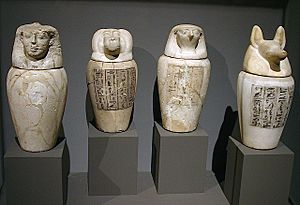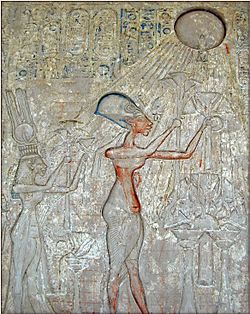Religion of Ancient Egypt facts for kids
The religion of ancient Egypt was a system of beliefs and practices that lasted for thousands of years. The ancient Egyptians believed in many different gods and goddesses. This is called polytheism. Over time, their beliefs changed as new leaders came to power.
Eventually, around 300 AD, Christianity began to spread across Egypt. Later, in the 7th century, Islam was introduced. By the 10th century, most Egyptians had become Muslim. These new religions came from outside Egypt and gradually replaced the ancient Egyptian religion.
Contents
Who Were the Egyptian Gods?
Ancient Egypt had different groups of people, and each group had its own special beliefs and main gods. For example:
- The people in Heliopolis believed in Atum, sometimes called Atum-Ra.
- In Hermopolis, Thoth was a very important god.
- The city of Thebes honored Amun, Mut, and Khonsu.
- In Memphis, the gods Ptah, Sekhmet, and Nefertem were worshipped.
Sometimes, different gods were combined into one. This happened when two powerful gods became linked, like Ra and Amun becoming Amun-Ra during the New Kingdom. This mixing of gods is called syncretism.
How the World Began: Egyptian Myths
The ancient Egyptians believed that at the very beginning, the universe was just dark water. The first god, Re-Atum, appeared from this water. Re-Atum then created the gods Shu, who was the god of air, and Tefnut, the goddess of moisture.
Shu and Tefnut had two children: Nut, the goddess of the sky, and Geb, the god of the Earth. When Shu and Tefnut got lost in the darkness, Re-Atum sent his eye to find them. When they were found, Re-Atum's happy tears turned into the first humans.
Nut and Geb fell in love, but Shu didn't want them together. He became the air that separated the sky from the ground. Shu also said that Nut could not give birth on any day of the 360-day year. Nut asked Thoth for help. Thoth, the god of wisdom, played a game with the moon-god Khonsu and won five extra days. Nut then had one child on each of these new days: Osiris, Isis, Set, Nephthys, and Horus-the-Elder.
The Story of Osiris and Horus
Osiris became the first king of Egypt. But his brother, Seth, was jealous and murdered him to take the throne. Seth then tore Osiris's body into many pieces. Isis, Osiris's wife, found the pieces and put them back together.
After Seth became king, Osiris's son, Horus, fought him. Horus won, and Seth was sent away to the desert, becoming the god of terrible storms. Anubis, the god of mummification, prepared Osiris's body, and Osiris became the God of the dead and the afterlife. Horus then became the new king of Egypt. The ancient Egyptians believed that their pharaohs were descendants of Horus.
What Happened After Death?
The ancient Egyptians had strong beliefs about what happened after death. They thought that a person's soul had different parts, like the ka and the ba. For these parts to reunite and live peacefully in the afterlife, the body needed to be preserved. This is why they developed mummification.
At first, bodies were buried in reed coffins in the hot sand, which dried them naturally. Later, they built wooden tombs and developed a long process of mummification. This involved carefully removing soft organs, washing the body, and packing it with a special salt called natron. The body was also covered in natron to dry it out.
The heart was usually left inside the body because Egyptians believed it was the home of the soul and a record of a person's life. Other organs were placed in special 'canopic jars'. Each jar had a lid shaped like one of Horus's sons, who guarded the organs:
- Imsety (human head) guarded the liver.
- Hapi (baboon head) guarded the lungs.
- Duamutef (jackal head) guarded the stomach.
- Qebehsenuef (falcon head) guarded the intestines.
After drying, the body was coated with resin and wrapped in linen bandages. Religious charms, called amulets, were often placed within the wrappings. For royalty, the mummy was placed inside many nested coffins, and then into a stone sarcophagus.
The Journey to the Afterlife
The Book of the Dead was a collection of spells, songs, and pictures written on papyrus. These were placed with the dead to help them on their journey through the underworld.
The journey was full of challenges, like lakes of fire and strange creatures. Finally, the soul would reach the Hall of Judgment in Duat. Here, Anubis, the god of mummification, would lead the deceased. The person's heart was then weighed against a single feather, which represented Ma'at, the goddess of truth and order.
- If the heart was lighter than the feather, it meant the person had lived a good life. Their soul would then go to Aaru, a paradise ruled by Osiris.
- If the heart was heavy with guilt, it meant the person had done bad things. This heart would be eaten by Ammit, a terrifying creature that was part crocodile, part lion, and part hippopotamus. If Ammit ate the heart, the soul would be destroyed forever.
A Time of One God
For a short time, during the rule of Pharaoh Akhenaten, Egypt focused on worshipping only one god. This was the sun god Aten. The Aten was shown as a sun disk with rays reaching out. Akhenaten even built a new capital city called Amarna with temples just for Aten.
This idea of worshipping only one god, called monotheism, didn't last long. After Akhenaten's death, his son Tutankhamun quickly brought back the worship of all the old Egyptian gods.
Some historians believe that during this time, people still worshipped the royal family as gods who got their power from Aten. There are pictures showing Akhenaten, his wife Nefertiti, and their daughters praying to the Aten's rays.
After the time of Akhenaten, the traditional Egyptian gods were worshipped again. This continued until Coptic Christianity and later Islam became the main religions in Egypt.
Important Egyptian Gods
- Anubis (god of mummification and the afterlife)
- Ptah (creator god, god of craftsmen)
- Ra (sun god)
- Osiris (god of the underworld and rebirth)
- Isis (goddess of magic, healing, and motherhood)
- Horus (sky god, protector of the pharaohs)
- Nephthys (goddess of mourning and protection)
- Seth (god of chaos, storms, and deserts)
- Bes (protector of households, mothers, and children)
- Sobek (crocodile god, god of the Nile)
- Sekhmet (goddess of war and healing)
- Min (god of fertility and reproduction)
Images for kids
-
Statue of Khafre, an Old Kingdom pharaoh, embraced by Horus
-
Ra (at center) travels through the underworld in his barque, accompanied by other gods
-
First pylon and colonnade of the Temple of Isis at Philae
-
Amulet in the shape of the Eye of Horus, a common magical symbol
-
The pyramid complex of Djedkare Isesi
See also
 In Spanish: Religión del Antiguo Egipto para niños
In Spanish: Religión del Antiguo Egipto para niños













